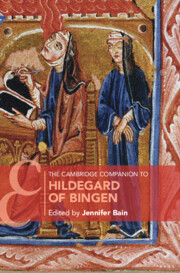Book contents
- The Cambridge Companion to Hildegard of Bingen
- The Cambridge Companion to Hildegard of Bingen
- Copyright page
- Dedication
- Contents
- Figures
- Tables
- Music Examples
- Contributors
- Acknowledgments
- Introduction
- Part I Life and Monastic Context
- Part II Writings and Reputation
- Chapter 4 Hildegard of Bingen’s Theology
- Chapter 5 Reading Hildegard of Bingen’s Letters
- Chapter 6 From the Roots to the Branches: Greenness in the Preaching of Hildegard of Bingen and the Patriarchs
- Chapter 7 Hildegard of Bingen: Illness and Healing
- Chapter 8 The Pentachronon and Hildegard of Bingen’s Reputation As a Prophet
- Chapter 9 The Context and Reception of Hildegard of Bingen’s Visions
- Part III Music, Manuscripts, Illuminations, and Scribes
- Select Bibliography
- Index
- Cambridge Companions To …
- References
Chapter 8 - The Pentachronon and Hildegard of Bingen’s Reputation As a Prophet
from Part II - Writings and Reputation
Published online by Cambridge University Press: 28 October 2021
- The Cambridge Companion to Hildegard of Bingen
- The Cambridge Companion to Hildegard of Bingen
- Copyright page
- Dedication
- Contents
- Figures
- Tables
- Music Examples
- Contributors
- Acknowledgments
- Introduction
- Part I Life and Monastic Context
- Part II Writings and Reputation
- Chapter 4 Hildegard of Bingen’s Theology
- Chapter 5 Reading Hildegard of Bingen’s Letters
- Chapter 6 From the Roots to the Branches: Greenness in the Preaching of Hildegard of Bingen and the Patriarchs
- Chapter 7 Hildegard of Bingen: Illness and Healing
- Chapter 8 The Pentachronon and Hildegard of Bingen’s Reputation As a Prophet
- Chapter 9 The Context and Reception of Hildegard of Bingen’s Visions
- Part III Music, Manuscripts, Illuminations, and Scribes
- Select Bibliography
- Index
- Cambridge Companions To …
- References
Summary
This chapter introduces readers to the most popular work through which Hildegard of Bingen was known throughout Europe in the centuries after her death, the Pentachronon (also known as the Speculum futurorum temporum siue Pentachronon sancte Hildegardis). The Pentachronon is an anthology of excerpts from Hildegard’s authentic writings that was created by Gebeno of Eberbach in the early thirteenth century and it enjoyed a pan-European circulation through the seventeenth century. This sophisticated anthology includes Hildegard’s apocalyptic prophecies of present and future history from the Scivias, the Book of Divine Works, and her letters, as well as excerpts from her correspondence in which she offered spiritual direction and counsel through her prophetic gift. An overview of the main apocalyptic narrative of the anthology is provided and particular attention is paid to the way in which Hildegard as a prophet and her apocalyptic teachings were presented for premodern readers in the three main versions of the anthology.
- Type
- Chapter
- Information
- The Cambridge Companion to Hildegard of Bingen , pp. 170 - 188Publisher: Cambridge University PressPrint publication year: 2021



